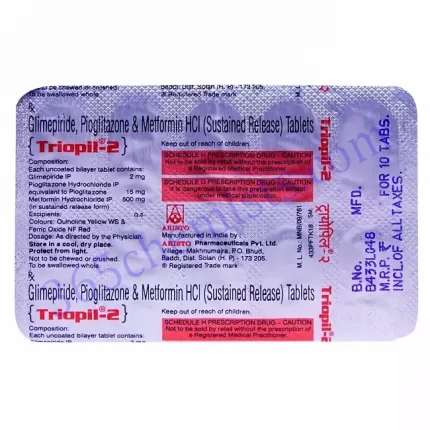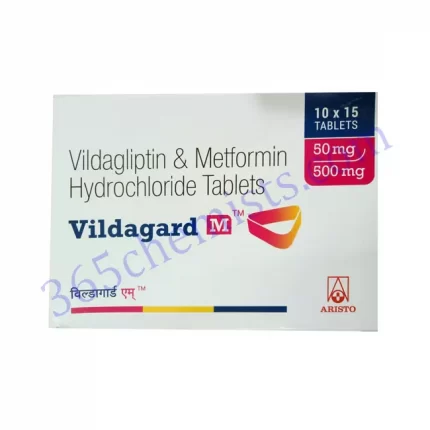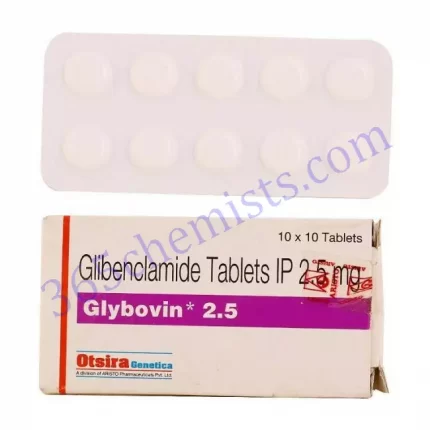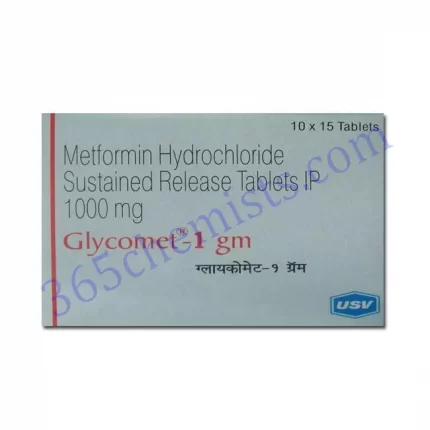Triopil 1 Tablet: A Comprehensive Review of Glimepiride, Metformin, and Pioglitazone Combination Therapy
Glimepiride, Metformin, and Pioglitazone are the three active components included within a single tablet of the drug known as Triopil 1 Tablet. This combo treatment has been developed with the express purpose of providing efficient management of diabetes type 2. The goal of treating diabetes with Triopil 1 Tablet is to improve insulin sensitivity, regulate blood glucose levels, and achieve better overall glycemic control by attacking many elements of the condition in a synergistic manner. In the following paragraphs, we will present a comprehensive analysis of Triopil 1 Tablet, discussing its make-up, the mechanism by which it exerts its therapeutic effects, the benefits to patients, the dosage that is suggested, and the potential adverse effects.
Composition and Mechanism of Action
Glimepiride, Metformin, and Pioglitazone are the active components that can be found in one tablet of Triopil. Glimepiride is a medication that belongs to the sulfonylurea class and it encourages insulin release from the beta cells that are located in the pancreas. Metformin is a type of medication known as a biguanide. It works by decreasing the amount of glucose that is produced by the liver and increasing the amount of glucose that is taken in by the body’s peripheral tissues. Pioglitazone is a thiazolidinedione that stimulates peroxisome proliferator-activated receptor-gamma (PPAR-gamma) receptors. As a result, insulin’s ability to do its job is enhanced, and glucose utilisation is raised.
The comprehensive treatment of the underlying pathophysiology of type 2 diabetes provided by Triopil 1 Tablet, which combines the actions of Glimepiride, Metformin, and Pioglitazone, is achieved through the combination of these three medications. Glimepiride increases insulin secretion, Metformin lowers insulin resistance, and Pioglitazone improves insulin sensitivity. All three medications treat type 2 diabetes. This combination medication helps successfully manage blood glucose levels and maintain optimal glycemic control by treating many elements of the condition. As a result, the disease can be more effectively treated.
Therapeutic Benefits
Patients suffering from type 2 diabetes can take advantage of a variety of therapeutic benefits provided by Triopil 1 Tablet. Glimepiride, Metformin, and Pioglitazone are three medications that, when used together, provide complete care of the illness and help minimise the risk of complications. The following is a list of the primary benefits of using Triopil 1 Tablet:
- Glycemic Control: Triopil 1 Tablet works to successfully lower blood glucose levels by increasing insulin release, lowering insulin resistance, and improving insulin sensitivity. This is how it achieves its goal of providing glycemic control. This results in better control of glycemic levels as well as lower levels of HbA1c.
- Metformin and pioglitazone both have positive effects on body weight, making them useful for weight management. They are able to aid people who are overweight or obese in properly managing their weight while also reducing the levels of glucose in their blood effectively.
- Protection of the Cardiovascular System Pioglitazone, which is present in the Triopil 1 Tablet, is one of the ingredients that has been linked to the protection of the cardiovascular system. These benefits include improved lipid profiles and a lower risk of cardiovascular disease.
- Renal Protection: There is evidence from a number of studies that the usage of metformin in people who have type 2 diabetes may have renal protective effects, hence lowering the likelihood of diabetic nephropathy.
Related Product
Triopil 1mg Tablet
Triopil 2mg Tablet
Dosage and Administration
A healthcare practitioner should evaluate the individual’s medical condition, blood glucose levels, and reaction to treatment in order to establish the appropriate dosage of Triopil 1 Tablet to provide. It is vital to take the medication exactly as directed by the healthcare practitioner, including taking the specified dosage and following all of the instructions.
The typical starting dose of Triopil 1 Tablet is one tablet, to be taken orally once daily with meals. This is the recommended starting dose. The tablet ought to be ingested in its entirety without being broken up, chewed on, or crushed in any way. It is possible to modify the dosage in accordance with the individual’s glycemic response and level of tolerance. It is essential to do consistent monitoring of blood glucose levels in order to determine how effectively the medication is working.
Potential Side Effects
There is always a chance that Triopil 1 Tablet will cause adverse reactions, just like any other medicine. The likelihood of experiencing side effects and the degree to which they manifest can differ from person to person. It is essential to be aware of the potential for adverse reactions and to seek the advice of a qualified medical practitioner if any symptoms that cause worry present themselves. Infrequent but possible adverse reactions to Triopil 1 Tablet include:
- Hypoglycemia can occur because one of the components, glimepiride, can reduce the levels of glucose in the blood too much, which can cause hypoglycemia. There is a possibility of experiencing symptoms such as vertigo, shakiness, sweating, confusion, and blurred vision.
- Metformin is known to cause gastrointestinal side effects, including nausea, vomiting, diarrhoea, and stomach discomfort. These symptoms may appear at any time throughout treatment with the medication. These symptoms are typically temporary and will go away once some time has passed.
- Pioglitazone has been linked to cases of fluid retention and edoema in some patients. This condition is characterised by swelling of the extremities. During treatment with Triopil 1 Tablet, it is essential to keep a close eye out for any signs of edoema, including swollen ankles or rapid weight gain.
Conclusion
Glimepiride, Metformin, and Pioglitazone are the three components that make up the combination medication known as Triopil 1 Tablet, which is used to effectively manage type 2 diabetes mellitus. This drug offers a comprehensive approach to the management of diabetes, including glycemic control, management of weight, and the possibility of protection for the cardiovascular system and the kidneys. It is extremely important to take the medication exactly as directed and to discuss any worries or adverse effects with a qualified medical expert. Individuals who have type 2 diabetes can enhance their general health and well-being as well as obtain improved control over their blood glucose levels by including Triopil 1 Tablet as part of an all-encompassing treatment strategy.












